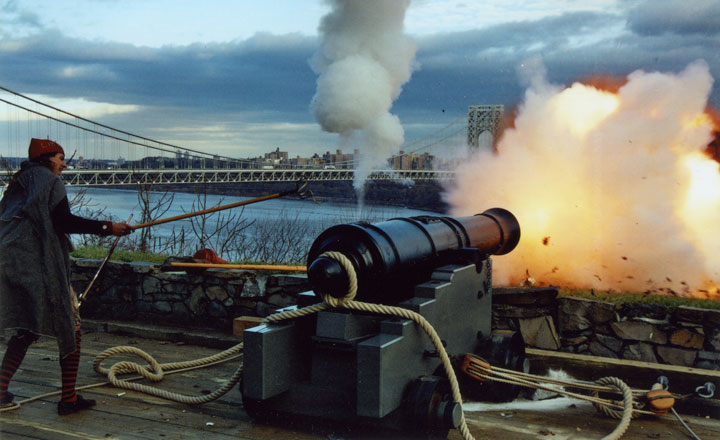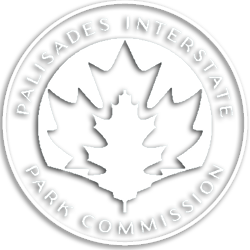Fighting for the Fort
A “Cliff Notes” Story by Elisabeth Murphy Henderson
November 2000
On May 24, 2000, a red oak donated by the family and friends of Dr. Peter Henderson was planted at the northern overlook in Fort Lee Historic Park. Dr. Henderson passed away on August 12, 1994. The oak was planted in tribute to the contributions he made to the recognition and preservation of the Fort Lee site and the significant part it played in the American Revolution.
The text of a eulogy written by Mrs. Henderson for the occasion follows.
To be sure, others were also deeply engaged in the efforts to preserve this unique historic site. Likewise, some of Dr. Henderson’s theories about the events of November 1776 have been challenged by other researchers. Mrs. Henderson’s account nevertheless offers us a glimpse of a unique individual engaged in a deeply personal fight — a fight for our common, public heritage.
EN

Peter Henderson was from the Peter Henderson Seed Company Hendersons in Jersey City, New Jersey. He was born January 5, 1908, and his parents expected he would enter their family business. In high school, however, Peter was the school sports writer and became very much interested in journalism, taking his weekly report to Jersey City’s Jersey Journal. One of the editors there became interested in Peter and told him of the journalism classes he had attended at the University of North Carolina at Chapel Hill. The youth was so intrigued that he visited Chapel Hill and came back enrolled in the University Journalism School.
I was working on my master’s degree in English during Pete’s senior year, and the rest is history. We were married in 1935 and moved to Haworth, New Jersey, on the day Pearl Harbor was attacked, December 7, 1941. We had thought it would be a very happy day. We had a new home, our son, Bruce, would be three years old on December 8, and Pete was well liked at the Dwight Morrow High School in Englewood, where he taught journalism.
Pete would never avoid a war that threatened his country. A real patriot, he did what I knew he would and joined the Army. Never one to stay in the background, Pete, I felt, would be killed in battle. But the Lord answered my prayers, and Pete, much to his disappointment, never saw battle. The day before he was to be shipped to Europe, a call went out to all camps in the United States, seeking a soldier to edit the Fort Meade, Maryland, newspaper and handle orientation and the radio work. Pete was immediately chosen and remained at Fort Meade for the duration of the war.
With the war’s end Pete returned to Haworth and resumed teaching in Englewood.
His fascination with the bluff at Fort Lee had begun when as a boy he saw on the cover of the Saturday Evening Post Willard Ortlip’s picture of General Washington standing on the bluff watching the downfall of Fort Washington across the Hudson River.
When we went up on the bluff we were sad to see that the area was overgrown, with no marker of any sort identifying its importance.
In 1953 Pete was amazed and angered upon reading in our daily newspaper that the Fort Lee town council would meet and consider, among other matters, the possibility of selling the bluff area below the George Washington Bridge to developers interested in building hotels there.
We went to the meeting, and I was frightened when I recognized the potential buyers as gangsters I had seen on the televised Kefauver Commission portrayal. The three men had their say and the councilmen seemed pleased. And then Pete got up. Always a good speaker, he outdid himself. When he finished there was stunned silence. The town could use the money a sale would bring, but the council members were not unpatriotic. The mayor finally announced that they would pursue the matter further, and the meeting adjourned. As we left the building I could almost see Pete’s mind planning his next move.
Outside the building a woman came up to us and introduced herself as representing the Rockefellers. She asked Pete if he had proof that the bluff was indeed used during the American Revolution. When he sadly replied that he had no proof that would hold in court, she replied that if there was proof, then the Rockefellers would purchase the area to add it to the parklands that went north of the bridge all the way to the New York state line. Pete assured the woman that he would get the proof, and we parted company with her.
Pete had already said he would go to Washington someday to look in the Library of Congress, where he felt the proof must be found. Bergen County was populated by Indians and Dutch farmers during the Revolution, and there was little written down. Pete had already visited descendants of early settlers in Fort Lee and Edgewater and gotten their stories about “Fort Constitution,” as it was originally called, and “Fort Lee,” as it was to become.
When school closed in June, Pete went to Washington DC. The authorities at the Library of Congress were very nice, but had no information other than to tell Pete that if there was any information on the matter, it would be in the archives in the basement. Pete descended into the spider-infested, musty, hot basement and went to work. It was time consuming and frustrating, but perseverance was one of Pete’s chief characteristics, and he finally found the proof he needed.
Although Pete handed the Rockefellers their proof, the battle was far from won. For the next three years the Fort Lee Council wavered between patriotism and finances. With the help of his good friend and fellow teacher Eleanor Harvey, Pete mobilized high school students, who enthusiastically took up the cause. At one of the Council Meetings, Ben Marden, owner of the Riviera nightclub above the George Washington Bridge, assured the audience that most of the members of nobility had visited his club, and not one of them had ever asked him where General Washington had stood and watched the fall of Fort Washington across the Hudson River.
The Palisades Interstate Park Commission already owned the sixteen acres south of the Bluff, so only the fourteen acres in the northern area owned by Fort Lee or its Board of Liquidation were involved. Finally the philanthropic organization Sealantic Fund acquired the northern area, and the Palisades Interstate Park Commission could merge all the cliff-front holdings into one park, with of course the blessings of the Rockefellers.
Word soon reached Bergen County people of the fact that had Lord Cornwallis captured General Washington at Fort Lee, this country might still be a British Colony. People began to view Fort Lee with respect and as a site of national importance. The little town of Closter boasted that it was their townsman who had alerted the men at Fort Lee to the approach of Cornwallis. And thereby hangs a tale. Although it had always been accepted that on the cold dark night of November 19, 1776, Cornwallis led his five thousand troops with all their guns and cannons up the Palisades past the so-called inn now called “the Cornwallis House” at Closter Dock, there sprang up a group declaring that Cornwallis did not land at the Closter dock, but at Huyler’s Landing. Pete felt that five thousand men would not all have gone up a single path, even though there was a dock there. Instead he felt that the men might well have gone up different areas. That did not, however, mean no one went up Closter Dock. Indeed, Pete took up the battle and debated for Closter so convincingly that he was then and there made an honorary citizen of Closter by the mayor. Peter debated to an enthusiastic crowd at Fairleigh Dickinson University, and finally in Newark at the State Historic Society headquarters. And Closter still brings out its horseman on November 20.
Deeply interested in Greenbrook Sanctuary in Alpine, Pete was elected a Director there and served faithfully. But his greatest interest was in what was to become Fort Lee Historic Park — which is there today due largely to Pete Henderson’s efforts.
April 16, 2000

